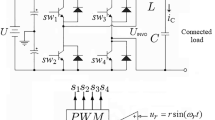Abstract
This paper presents an adaptive sliding-mode control (ASMC) technique for a three-phase UPS system with an auto-tuning mechanism of the switching gain. First, a sliding-mode control (SMC) scheme for the three-phase UPS inverter is designed to guarantee the robustness against the system uncertainties and external disturbances. Then, through addition of an adaptive control term, the ASMC algorithm is developed to optimize the switching gain without the prior information of the unknown and bounded uncertainties. It is shown that the upper bounds of the uncertainties are not required to be known in the SMC design. Also, the chattering problem in the reaching mode is considerably alleviated and the excessive use of electric power can be reduced by avoiding overestimation of the switching gain. Both the stability and robustness of the proposed ASMC method are proven by using the Lyapunov theory. In addition, a simple sliding-mode observer is used to estimate the load current without any additional current sensors. Therefore, the proposed ASMC system can accomplish the superior control performance (such as faster voltage recovery under a sudden load change, smaller steady-state error under parameter deviations, and lower THD under nonlinear load) compared to the conventional SMC scheme. Finally, the performance verifications of the proposed algorithm are carried out through the comparative simulation and experimental results on a prototype 1-kVA three-phase UPS inverter using TMS320F28335 DSP.








Similar content being viewed by others
References
Celebi M, Alan I (2010) A novel approach for a sinusoidal output inverter. Electr Eng 92:239–244. doi:10.1007/s00202-010-0181-3
Bin L, Loh PC, Elangovan S (2002) A universal conditioner with optimized system performance. Electr Eng 84:159–164. doi:10.1007/s00202-002-0115-9
Nasiri A (2007) Digital control of three-phase series-parallel uninterruptible power supply systems. IEEE Trans Power Electr 22(4):1116–1127
Tanrioven M, Alam MS (2006) Modeling, control, and power quality evaluation of a PEM fuel cell-based power supply system for residential use. IEEE Trans Ind Appl 42(6):1582–1589
Loh PC, Newman MJ, Zmood DN, Holmes DG (2003) A comparative analysis of multiloop voltage regulation strategies for single and three-phase UPS systems. IEEE Trans Power Electr 18(5):1176–1185
Li G, Ji SM, Tan DP (2013) Multiple-loop digital control method for a 400-Hz inverter system based on phase feedback. IEEE Trans Power Electr 28(1):408–417
Kojima M, Hirabayashi K, Kawabata Y (2004) Novel vector control system using deadbeat-controlled PWM inverter with output LC filter. IEEE Trans Ind Appl 40(1):162–169
Mattaveli P (2005) An improved deadbeat control for UPS using disturbance observers. IEEE Trans Ind Electr 52(1):206–212
Cortes P, Ortiz G, Yuz IJ, Rodriguez J, Vazquez S, Franquelo LG (2009) Model predictive control of an inverter with output LC filter for UPS applications. IEEE Trans Ind Electr 56(6):1875–1883
Jiang S, Cao D, Li Y, Liu J, Peng FZ (2012) Low-THD, fast-transient, and cost-effective synchronous-frame repetitive controller for three-phase UPS inverters. IEEE Trans Power Electr 27(6):2994–3004
Deng H, Organti R, Srinivasan D (2007) Analysis and design of iterative learning control strategies for UPS inverters. IEEE Trans Ind Electr 54(3):1739–1751
Kim DE, Lee DC (2010) Feedback linearization control of three-phase UPS inverter systems. IEEE Trans Ind Electr 57(3):963–968
Zhang X, Sun L, Zhao K, Sun L (2013) Nonlinear speed control for PMSM system using sliding-mode control and disturbance compensation techniques. IEEE Trans Power Electr 28(3):1358–1365
Hao X, Yang X, Liu T, Huang L, Chen W (2013) A sliding-mode controller with multiresonant sliding surface for single-phase grid-connected VSI with an LCL filter. IEEE Trans Power Electr 28(5):2259–2268
Eker I, Akmal SA (2008) Sliding mode control with integral augmented sliding surface: design and experimental application to an electromechanical system. Electr Eng 90:189–197. doi:10.1007/s00202-007-0073-3
Kukrer O, Komurcugil H, Doganalp A (2009) A three-level hysteresis function approach to the sliding-mode control of single-phase UPS inverters. IEEE Trans Ind Electr 56(9):3477–3486
Li P, Zheng ZQ (2012) Robust adaptive second-order sliding-mode control with fast transient performance. IET Control Theory Appl 6(2):305–312
Zhu Z, Xia Y, Fu M (2011) Adaptive sliding mode control for attitude stabilization with actuator saturation. IEEE Trans Ind Electr 58(10):4898–4907
Huang YJ, Kuo TC, Chang SH (2008) Adaptive sliding-mode control for nonlinear systems with uncertain parameters. IEEE Trans Syst Man Cybern Part B Cybern 38(2):534–539
Leu VQ, Choi HH, Jung JW (2012) Fuzzy sliding mode speed controller for PM synchronous motors with a load torque observer. IEEE Trans Power Electr 27(3):1530–1539
Mondal S, Mahanta C (2012) Adaptive second-order sliding mode controller for a twin rotor multi-input-multi-output system. IET Control Theory Appl 6(14):2157–2167
Shahian B, Hassul M (1993) Control system design using Matlab. Prentice-Hall Inc., New Jersey
Skarrie H (2001) Design of powder core inductors. Dissertation, University of Lund, Sweden
Acknowledgments
This work was supported by the National Research Foundation of Korea (NRF) grant funded by the Korea government (MSIP, Ministry of Science, ICT & Future Planning) (No. 2012R1A2A2A01045312).
Author information
Authors and Affiliations
Corresponding author
Rights and permissions
About this article
Cite this article
Choi, Y.S., Choi, H.H. & Jung, J.W. An adaptive sliding-mode control technique for three-phase UPS system with auto-tuning of switching gain. Electr Eng 96, 373–383 (2014). https://doi.org/10.1007/s00202-014-0306-1
Received:
Accepted:
Published:
Issue Date:
DOI: https://doi.org/10.1007/s00202-014-0306-1




